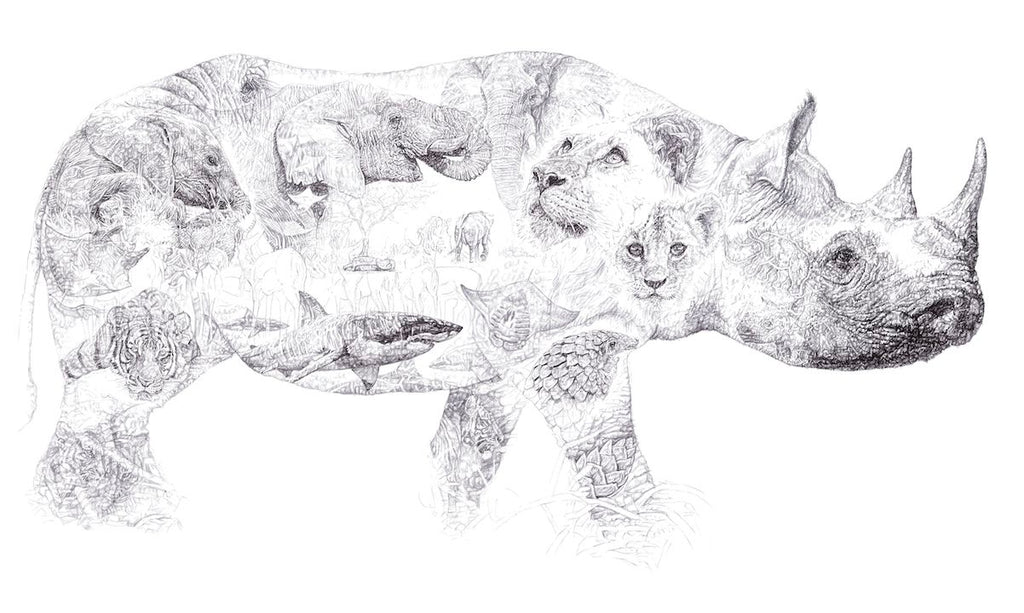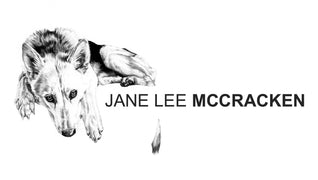Rhino

Rhino 2014 Biro drawing
This drawing was created for Chengeta Wildlife and inspired by some of the most hunted and trafficked species on the planet. It was also influenced by Sir David Attenborough's BBC series Africa. The drawing was auctioned in 2018 to raise funds for Chengeta.

Rhino 2014 Biro Drawing 'In Homage to "Africa"'
Inspired by Albrecht Dürer’s ionic drawing Rhinoceros, 1515, Rhino Biro drawing symbolises man’s curiosity and relationship with the natural world, from Dürer’s epochal representation to the present day. Within 500 years of Dürer’s creative legacy, rhinoceros species teeter on the brink of extinction alongside tigers, pangolin, sharks and other keystone species. Lions, elephants and manta ray have also reached threatened status. Where once rhinoceros roamed in vast numbers, treading a 50 million year old evolutionary path, from the 1600s onwards, rhino numbers have plummeted by 90%. Hunting, habitat loss and poaching for their horns to use in traditional Chinese medicine, factor amongst the reasons for their more recent and rapid decline. From a 16th century artist who executed man’s inquisitive propensity to study species never seen before in the west, this drawing underlines our vast 21st century knowledge of wildlife and the threats that face life on earth. Ultimately this piece aims to highlight the beauty, majesty and the importance of the depicted species, “ The creatures that inhabit this earth – be they human beings or animals – are here to contribute, each in its own particular way, to the beauty and prosperity of the world.” Dalai Lama.
 Albrecht Dürer ‘Rhinoceros’, (below)
Albrecht Dürer ‘Rhinoceros’, (below)
Paying homage to BBC documentary series Africa, 2013, the films are used as pivotal inspiration as the majority of species represented in this artwork are from the African continent. A monumental wildlife series, presented by David Attenborough Africa reveals the breath-taking beauty and fragility of Africa and the species inhabiting its lands. Jane photographed 1000’s of images of Africa as it played onscreen to give a sense of cinematic transience. There is also an evanescent quality, symbolising that species are disappearing at a rate beyond that of their natural cycle. By portraying specific animals that feature in Africa, presents the individualism of each animal, both aesthetically and characteristically; thus emphasising the fact that each animal is unique and precious to the survival of its species. Selecting some of the most poignant scenes from the documentary, including perhaps the most touching of all, the death from drought enforced starvation of an elephant calf and the “little chat” between David Attenborough and a blind rhino calf, Jane confronts the threats these species face both naturally and at the hands of man.
“Like it or not this generation is responsible for handing on the world’s wildlife to the next. No one knows what the future holds for this little creature (blind rhino calf), nor indeed what changes will take place on the great continent in which he lives ... but one thing is certain, what happens here is more important than it has ever been and that the relationship of the rest of the world to this great continent (Africa) and the creatures that live in it is more important than ever before. On whichever part of the planet we live we all have a part to play in what sort of future this wild continent has.” David Attenborough, ‘Africa’ epilogue.
 David Attenborough having a little chat with blind rhino calf - tv screen photograph of 'Africa'
David Attenborough having a little chat with blind rhino calf - tv screen photograph of 'Africa'
THE STORIES BEHIND THE IMAGES

Detail of 'Rhino' back
Elephant Calf (Rhino back) – depicting one of the most moving sequences from ‘Africa’ this drawing portrays the moment a starving elephant calf, too weak to hold up its head, collapses into the drought-ridden grass. This drawing symbolises that elephants endure natural adversities as well as poaching for their tusks.
Mother Elephant – layered above the dying calf is a drawing of its mother elephant weeping for the death of her calf. Having stood vigil and tried to revive the calf, she accepts its death. Elephants are the only known species apart from humans to practice ritual behaviour when confronting death, including grief and have been known to show the same emotions when encountering human death.
Adult Elephant – layered through the dying calf is an image of a triumphant adult elephant drinking from a water hole, celebrating the monumental greatness of the largest land mammal on earth, surrounded by the slight stature of gazelles and zebra.
South China Tigers, Mother, cubs & Male (back & front Rhino legs) - when Jane began drawing ‘Rhino 2014’ in early summer the official number of wild tigers was less than 3500. By August the official number is emerged as less than 3000 wild tigers. There are more tigers in captivity than in the wild. The small tiger cubs represent the future of tigers padding towards extinction, but ‘hope’ that it is possible not only to save wild tigers but all the species depicted in ‘Rhino 2014’.
Dead Elephant Calf and Mother Elephant – a tiny drawing through the centre of the piece shows the body of the dead calf lying in the dust and the moment the mother elephant senses she has to leave her calf and return to the herd. Left behind to tend the sick calf the herd are bound to continue their quest to find water and avoid further death. As she turns and walks away on her journey a faded image of another adult elephant beyond her indicates that she eventually reaches the herd.
Great White Sharks (layered through rhino body) – illustrating the grace of an enigmatic animal that has inhabited the earth for 500million years, Jane’s drawing features a shiver of great white sharks. Penetrating the ocean, sunlight flickers on the sharks bodies with the aim of encouraging appreciation of the beauty and necessity of sharks in a bid to dispel their negative populist image. Shark finning for shark fin soup is rapidly depleting shark species populations; eleven species are endangered.
Dancing Manta Rays (throughout artwork) – drawings manta rays appear throughout this piece and include a group of dancing manta rays layered through the central elephant’s ear. Hunted for their gill rakers to use in Chinese medicine the future of manta rays remains uncertain.

Detail of 'Rhino' Front
Starlit Rhino (Rhino Front)- the main face and body of ‘Rhino 2014’ is inspired from a sequence in ‘Africa’ capturing newly uncovered rhino behaviour. Deemed unsociable, film evidence reveals that rhinos actually gather at night to socialise at a secret watering hole.
Blind Rhino Calf (drawing on main Rhino face) – one of the stars of ‘Africa’, a blind rhino calf’s every move is guided by rangers. This drawing symbolises that each individual animal including this little rhino is precious and holds a key to the future security of its species.
Prehistoric Rhino Etching (drawing on main Rhino face) – prehistoric rock engraving of a rhino found in the Sahara becomes a layered drawing as if tattooed on the rhino’s skin and plays as a reminder as to how long rhinos have existed on earth.
Young Lion – portrait of a noble young lion suggests the majesty of ‘the king of the jungle’, but its eyes betray a reflective demeanour expressing that hunting and habitat loss have seen wild lion numbers plummet from 200,000 a century ago to fewer than 20,000. The lion gazes up towards ‘the future’.
Lion Cub (under main lion) – portrait of a lion cub personifies hope for the future of its species.
Pangolin (front leg of rhino) – armoured body of a pangolin clings on to the walking rhino’s leg, suggesting the precarious status of pangolin species, racing towards extinction, caught for food and used in Chinese medicine. Tens of thousands of pangolin are traded every year.

